This technique will work well on any still waters
SECTION: fresh feature
MAPS:
Facts
ILLUSTRATIONS: 0
I watched the small Predatek descend into the berley trail as the wind kicked hard off the jetty. That afternoon, I had already caught and released one small golden perch despite the conditions.
As the lure reached the bottom of the berley mix, the rod loaded up and the 4kg monofilament began tearing off my spool. After several strong head shakes, the weight on the end of the rod indicated a medium-sized cod but as the fish broke the surface and rolled onto its side, it became clear that it was an enormous yellowbelly close to 6kg.
During that afternoon I caught and released four more golden perch, a small Murray cod and 15 large redfin.
That was part of a week of superb native fishing at my local haunt in Canberra. A mixed bag of over 20 fish a day was the norm and some truly astonishing captures were recorded including three trophy-sized golden perch in one 50-minute session.
Until then I did not believe that short sessions could produce such outstanding results but lately I have been testing berley techniques and the outcomes have been phenomenal.
From this point onwards I will always use berley when committing to a certain spot. This article will outline different types of berley mix and how to maximise the best results from a freshwater berley trail through the use of lures and bait techniques.
I recommend preparing a berley mix the day before a session – the recipe is in a fact box hereabouts. Ideally, you would make enough mixture to use over three sessions.
I make three lots of this berley mix and take one down to my chosen location the day before a session.
To get the most out of berley it is important to choose a location where much of ingredients will linger into the following day.
My best sessions lately have been focused on jetties and rowing pontoons. I find that these structures are good because some of the berley inevitably gets caught around the submerged timber and metal brackets used to support these platforms.
When berleying an area, start by releasing some of the mixture at the base of the structure and gently release the rest evenly out from your position.
Do this three or four times until all of the berley has been cast into the water.
Parts the berley will sink quickly while other parts will linger at various depths in the water column. Ensure that you berley in the late afternoon so that you can be guaranteed that some mix will still be there in the morning.
I like to fish the berley trail on a windy day when the berley will drift a considerable distance. The wind stirs up the water and in turn the bottom of the river or lake. Insects and other aquatic creatures are awakened and therefore so are the fish.
I use a Daiwa Sol 2500 spin reel with a 6'10” Daiwa Procaster Z rod with 4kg monofilament and a 6kg trace. I find this is the only way to go because some truly enormous carp and yellowbelly tend to turn up.
This combo is the best that I have owned as it is capable of handling big fish while still being able to cast small lures a long way.
Once a location has been berleyed effectively, there are several techniques for maximising the bite of fish mingling in the trail.
I have found that it is best to start with bait and switch the lures once one or two fish have found their way into the net.
This is because fish seem to go into a frenzy as live baits are dropped through the trail and are then more ready to attack lures.
Live yabbies drifted at the edge of the berley trail on a running sinker rig are incredibly effective when first casting into the mix. I don’t use large yabbies any more and prefer two medium yabbies placed on a baitholder hook. Both kick, often in opposite directions, and fish find this irresistible.
On the first day of testing this technique I caught two large yellowbelly, a small Murray cod and an enormous number of large redfin on small yabbies bunched together. At one point, as I reeled in one of the goldens, two smaller ones chased it almost into the net while swiping at the berley trail.
As the fish come on and off the bite, continue to berley with the mix from the previous day. I find this is paramount in ensuring the fish stay around the baits and lures.
I fish with the philosophy that you have done all this work to get them into the area, so why not keep them there.
If too many redfin (or, if you are extremely unlucky, carp!) start turning up in plague numbers and pinching baits, switch to lure for a while.
I find that even goliath redfin for the most part will avoid the larger lures that attract cod and yellowbelly.
It is important to use brightly coloured deep-divers when lure fishing a berley trail because they tend to stand out against the darker colours of the mix. I find red Predatek minnows and fluorescent StumpJumpers very effective because both can dive quite deep and when retrieved effectively, should cover the entirety of the water column which contains the berley.
When retrieving, try a ‘figure-eight’ retrieve. This type of retrieve best mimics a wounded minnow and when worked in conjunction with the berley it is superb. Also, spray a little Ultrabite on your lure for added incentive.
I have found that the native fish caught on lures aren’t as big as those landed on bait but that could be coincidence.
Large bunches of scrub worms fished on paternoster rigs are also an excellent way to connect with a native fish sitting around the berley trail. The bigger the bunch of worms, the better. I caught my largest Yellowbelly of the Summer on a hook with four writhing scrubbies.
If the bait starts to get a bit old and ragged, spray a small amount of Ultrabite on the worm and snip the bottom of its tail. In this way you are using the scent of the bait with that of the pheromones released by the Ultrabite.
A small bardi grub wrapped in a scrub worm is a strange but incredibly potent bait in these situations and seems to work when other baits fail.
Lamentably, this bait seems to be a favourite with European carp as well as native fish so be prepared for a few unwanted captures.
In a week of fishing this way I have landed over 30 golden perch (up to six a session) and uncountable numbers of redfin along with the odd Murray cod and the occasional carp.
I have never experienced fishing of this calibre before and the only thing I do differently is to berley the night before, throughout the session the next day and then again at the end of the session.
If you are not using berley and have caught the odd native at your local spot, try berleying the position. I can almost guarantee that a lot more fish will turn up.
Facts
With pic 8
THE BERLEY RECIPE
With pic 8
In a half-litre container mix chopped garden worms, brown bread, one tablespoon of raw linseed oil, chopped scrub worms and yabby heads. Spray over with one teaspoon of Ultrabite Freshwater Formula and then work it through the mix. Allow sit to settle for at least 20 minutes before use.

A Predatek Boomerang is a great lure to use in the berley trail. Red works well because it makes the lure stand out from the berley.
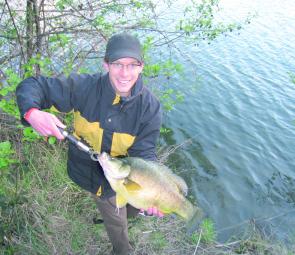
Big golden perch are a great way to put a smile on your dial.
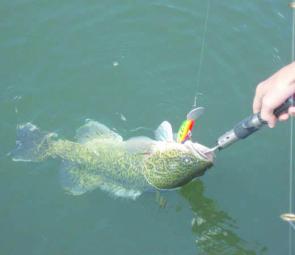
Murray cod are often attracted to the berley to see what all the fuss is about and then don’t mind hitting a lure.
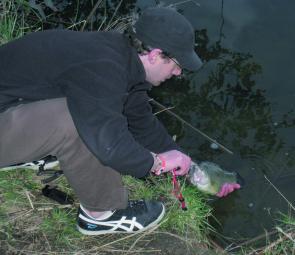
Releasing a small golden that inhaled a bardi grub wrapped in a scrub worm.
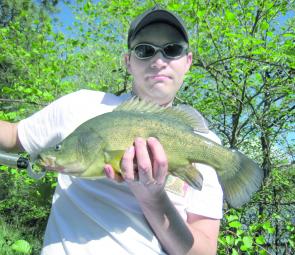
Once the berley has taken effect, small golden perch can turn up in big numbers.
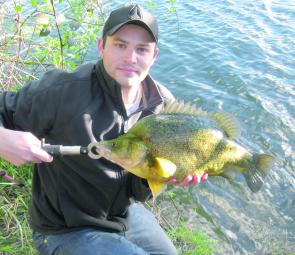
Big baits, big fish: This slab of a golden ate a big bunch of scrub worms.
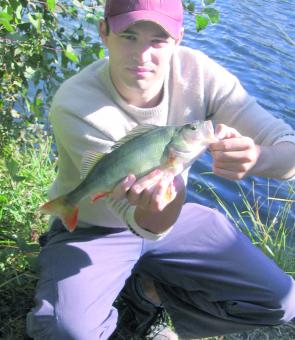
Redfin can often turn up in large numbers. After you’ve taken your fill, try a bigger lure to attract a golden or cod and avoid the reddies.
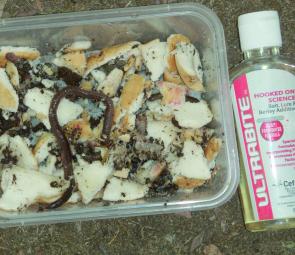
Two small yabbies rigged back-to-back make a deadly bait.





